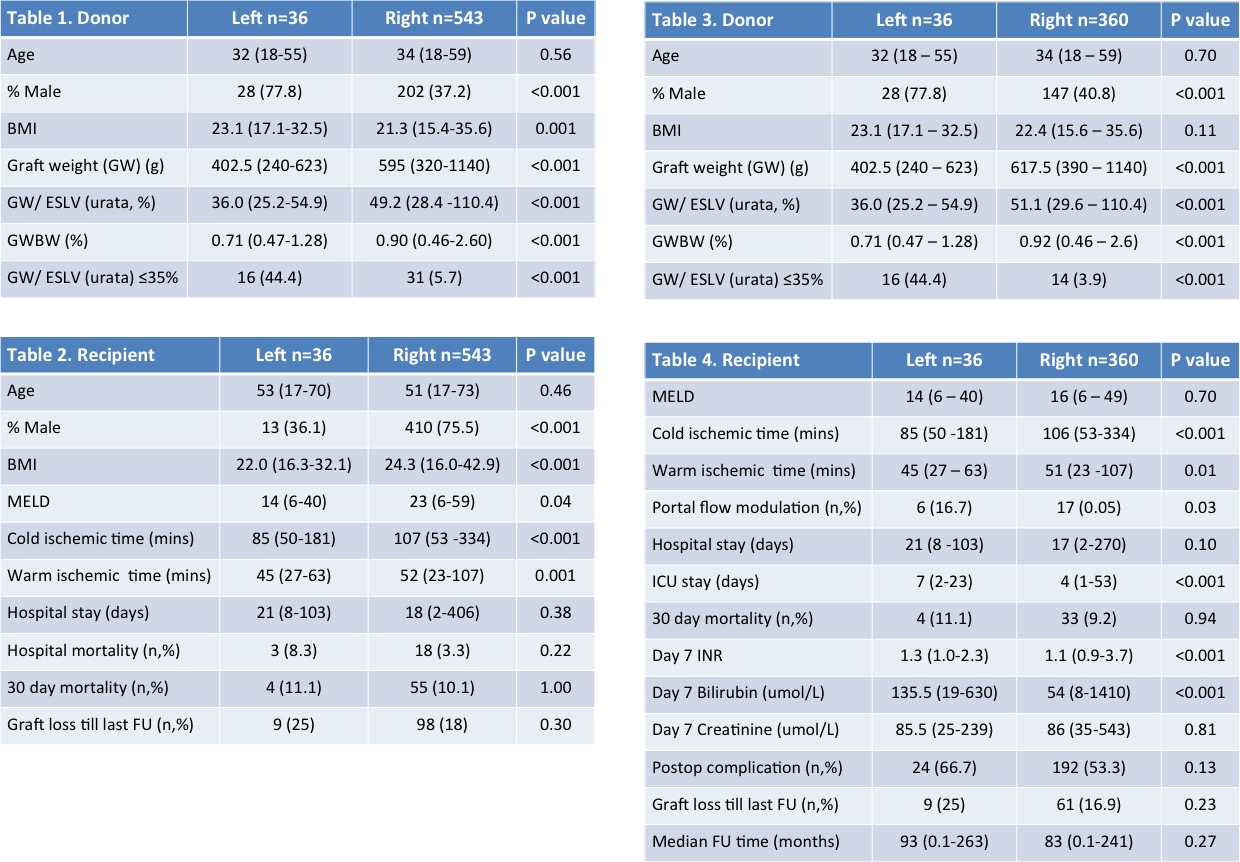Extending the Limit for Living Donor Liver Transplantation: Similar Outcomes After Left vs. Right Lobe Graft, a Propensity Score Analysis.
T. Wong, K. Ng, J. Fung, K. Chok, A. Chan, C. Lo.
Surgery, The University of Hong Kong, Hong Kong, Hong Kong
Meeting: 2017 American Transplant Congress
Abstract number: B222
Keywords: Graft failure, Liver transplantation, Living-related liver donors, Survival
Session Information
Session Name: Poster Session B: Living Donors and Partial Grafts
Session Type: Poster Session
Date: Sunday, April 30, 2017
Session Time: 6:00pm-7:00pm
 Presentation Time: 6:00pm-7:00pm
Presentation Time: 6:00pm-7:00pm
Location: Hall D1
Background
This study aimed to investigate the impact of graft selection (left vs. right lobe) in LDLT.
Method
This was a retrospective study that included all patients who had adult-to-adult LDLT at a university hospital in HK. Data was retrieved from a prospectively collected database from 1996 to 2015.
Results
There were 543 right and 36 left LDLT during study period.Graft weight (GW) of left lobe graft was significantly less than right lobe. 16/36 (44.4%) of left lobe graft had a GW/ESLV =<35%. Left lobe recipient has a lower median MELD (22 vs. 24.3, p<0.001). Table 1 and 2 showed donor and recipient demographics and outcomes.
Propensity score matching was done to adjust for 1) donor age, 2) donor BMI and 3) recipient MELD in ratio of 1:10. Table 3 and 4 illustrated donor/recipient outcomes after matching. No difference in patient/graft survival after left or right LDLT.
No difference in patient/graft survival after left or right LDLT.  Donors after left lobe had a shorter hospital stay (6vs.7 days, p=0.04), less complications (5.6vs.20%, p=0.03) and has a quicker recovery of liver function (peak INR 1.2 vs. 1.5, p<0.001; peak bilirubin 29 vs. 50 umol/L, p<0.001). Left lobe graft recipient required more portal flow modulation. There was no donor mortality in both group
Donors after left lobe had a shorter hospital stay (6vs.7 days, p=0.04), less complications (5.6vs.20%, p=0.03) and has a quicker recovery of liver function (peak INR 1.2 vs. 1.5, p<0.001; peak bilirubin 29 vs. 50 umol/L, p<0.001). Left lobe graft recipient required more portal flow modulation. There was no donor mortality in both group
In multivariable analysis, only recipient MELD significantly affected overall and graft survival (OR 0.97 [0.94-0.99], p=0.02) and (OR 0.97 [0.94-0.99], p=0.009).
Conclusions
Donor recovery was faster and with less complication after left lobe. The trade off was recipients more likely to require portal flow modulation, had a slower recovery of graft function and a longer ICU stay. Hospital mortality, graft and patient survivals were unaffected. In carefully selected recipients, outcomes after left and right lobe LDLT were safe and similar.
CITATION INFORMATION: Wong T, Ng K, Fung J, Chok K, Chan A, Lo C. Extending the Limit for Living Donor Liver Transplantation: Similar Outcomes After Left vs. Right Lobe Graft, a Propensity Score Analysis. Am J Transplant. 2017;17 (suppl 3).
To cite this abstract in AMA style:
Wong T, Ng K, Fung J, Chok K, Chan A, Lo C. Extending the Limit for Living Donor Liver Transplantation: Similar Outcomes After Left vs. Right Lobe Graft, a Propensity Score Analysis. [abstract]. Am J Transplant. 2017; 17 (suppl 3). https://atcmeetingabstracts.com/abstract/extending-the-limit-for-living-donor-liver-transplantation-similar-outcomes-after-left-vs-right-lobe-graft-a-propensity-score-analysis/. Accessed December 19, 2025.« Back to 2017 American Transplant Congress
